Overview
The Ingenuity Mars Helicopter and the Mars 2020 Perseverance rover launched together from Cape Canaveral, Florida, on July 30, 2020. Both will arrive at the surface of Mars’ Jezero Crater on Feb. 18, 2021. Once the Perseverance team has completed a detailed checkout of the rover’s systems and subsystems and once both the rover and helicopter teams have agreed upon a good drop-off location, Ingenuity will be deployed and begin its flight test program. This is expected to take place in the first few months after landing. The Ingenuity Mars Helicopter flight test program will span no more than 30 sols (a sol is one Mars day, which is 24 hours, 39 minutes, and 35.244 seconds).
As soon as the Ingenuity technology demonstration is complete, the Mars 2020 rover will transition into its science operations phase. During a prime mission that will last at least one Mars year (about 687 Earth days), Perseverance’s investigations in Jezero Crater will address high-priority science goals for Mars exploration – among them, searching for signs of ancient microbial life and collecting Martian rock and regolith (broken rock and dust) for future return to Earth. The results of Ingenuity’s flight test program will have no bearing on the Mars 2020 Perseverance rover mission’s science goals or success. Find more information about the mission in the Perseverance rover press kit.
Helicopter Objectives
The helicopter team has a sequence of objectives for this high-risk, high-reward project. The team has already successfully completed the first major objective:
To demonstrate powered flight in the thin atmosphere of Mars is possible.
- The Martian atmosphere is only about 1% as thick as Earth’s, making it very difficult to generate the lift necessary to fly.
- The team has successfully designed, built, and flight-tested Ingenuity in a Mars-like atmospheric environment in a special chamber on Earth.
After the testing on Earth, the team now aims:
To actually fly the helicopter on Mars.
- The flight tests at Mars will inform the team of the actual performance in the true environment of Mars compared to the models assumed for the environment and the flight tests that took place on Earth.
- The Ingenuity team will attempt up to five flight tests during its 30-sol experiment window. Each successful flight will allow the team to consider expanding the test envelope for the next flight. If data suggests the mission did not meet expectations, the team may elect to reproduce the previous flight profile.
- The helicopter will start each flight from a 33-by-33-foot (10-by-10-meter) airfield and end back in this airfield.
- The helicopter will fly at altitudes of 10-15 feet (3-5 meters) in altitude and travel as far as 160 feet (50 meters) downrange and back to the starting area.
- Engineers will fly the helicopter for no more than about 90 seconds on each flight.
The helicopter experiment will also inform engineers about:
Use of miniaturized flying technology in space.
- To fit within the payload space on the Perseverance rover’s belly while also maintaining the capability to fly in Mars’ thin atmosphere, Ingenuity was designed to be as light and compact as possible (about 4 pounds, or 1.8 kilograms, on Earth).
- Its onboard computers, batteries, sensors, and heaters all fit within a fuselage that is about the size of a tissue box.
- In addition to having to be small and lightweight, the helicopter’s components had to be stress-tested to be sure they could survive the cold temperatures and radiation in deep space and on Mars.
Autonomous operations of an aerial system at another planet or moon.
- Like the rover, the helicopter is too far from Earth to be operated with a joystick. So engineers will learn to operate the aerial vehicle from many millions of miles away.
- The helicopter is designed to fly, land, communicate, manage its energy, and keep warm autonomously.
- Innovative mathematical algorithms will allow flight in the thin atmosphere, keep track of the helicopter’s movements, and ensure it remains on the planned flight path.
Future Implications
The fundamental mathematical models, simulations, and design approach used for Ingenuity position NASA to consider incorporating small helicopters into mission plans for future robotic and human exploration at Mars.
- Taking to the air would give scientists a new perspective of a region’s geology and allow them to peer into areas too steep or slippery to send a rover.
- Future generations of Mars helicopters could provide a supporting role as robotic scouts, surveying terrain from above.
- These future helicopters could also collect samples or carry an instrument payload for in-situ scientific investigation. In addition, a future Mars helicopter could help carry light but vital payloads from one site to another.
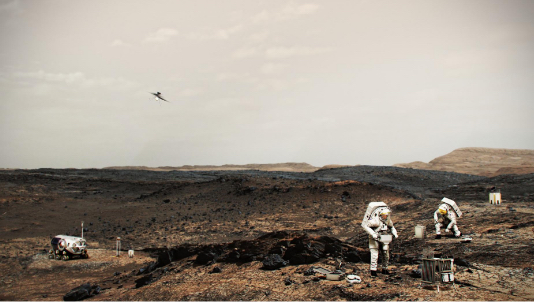 Image credit: NASA | Full image and caption
Image credit: NASA | Full image and caption
Getting to Mars
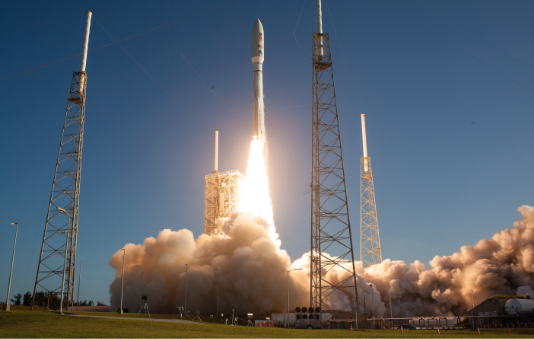 Image credit: NASA | Full image and caption
Image credit: NASA | Full image and caption
The Mars Helicopter was designed to fly at the Red Planet, but it needs help to survive the space environment and the extreme temperatures of interplanetary cruise or entry, descent, and landing (EDL) on Mars. For these phases of the project (as well as early surface operations before the helicopter’s deployment), Ingenuity will rely on the Mars 2020 Perseverance mission to provide power, a communications link to Earth, and shielding from both micrometeorites and entry heating.
The Perseverance rover, with Ingenuity attached to its belly and protected by a debris shield (that protects the helicopter from rocks kicked up during Perseverance’s landing), launched from Space Launch Complex 41 at Cape Canaveral Air Force Base on July 30, 2020, at 7:50 a.m. EDT (4:50 a.m. PDT) aboard a two-stage United Launch Alliance (ULA) Atlas V 541 rocket.
During cruise to Mars, the Perseverance rover, its descent stage, and the Ingenuity Mars Helicopter are encased inside a capsule known as an aeroshell; the aeroshell is attached to the disk-shaped, solar-powered cruise stage.
Among the numerous housekeeping tasks the mission team performs during cruise is a biweekly recharge of Ingenuity’s batteries. The closely monitored one- to two-hour operation includes checking the rotorcraft’s six lithium-ion batteries as well as bringing the charge level of each back up to about 35% – the level of charge the Ingenuity team has determined is optimal for battery health during cruise.
To reach the Martian surface, Ingenuity remains attached to Perseverance’s chassis as the rover’s EDL system carries them to the surface in a fast-paced set of milestones that last about seven minutes. Not only is the choreography of EDL complex, but the time delay involved in communicating with Earth means that the spacecraft has to accomplish this choreography all by itself. Many engineers refer to this complex sequence of events as the “seven minutes of terror.”
Find more information about Perseverance's interplanetary cruise and entry, descent, and landing in the Perseverance rover press kit.
Surface Phase
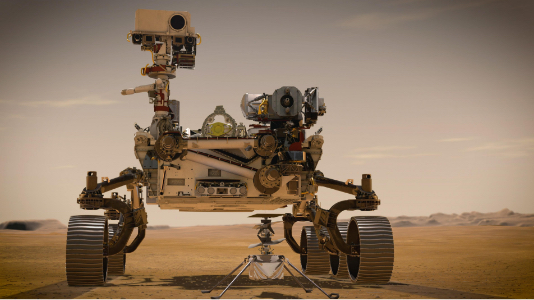 Image credit: NASA/JPL-Caltech | Full image and caption
Image credit: NASA/JPL-Caltech | Full image and caption
Early Surface Operations
The rover should touch down in the Martian afternoon – about 3:53 p.m. local mean solar time. Soon after, the rover’s computer switches from entry, descent, and landing (EDL) mode to surface mode. This initiates autonomous activities for Sol 0, the first Martian day on the surface of the Red Planet.
During Perseverance’s Surface Operations Transition Phase, engineers begin the commissioning process, checking to confirm that all rover systems, subsystems, and instruments are ready to proceed with surface mission objectives. Still connected to the belly of the rover via the Mars Helicopter Delivery System, Ingenuity will receive its own checkout as well as a battery charging within a couple sols of landing.
For the first few months, including the time the helicopter is conducting test flights, the Perseverance and Ingenuity operations teams will work on Mars time, which means they will be setting their clocks to sync with the Martian day (about 40 minutes longer than an Earth day). This allows them to respond quickly to any issue the rover or helicopter might have and to prepare revised instructions for the next sol.
Surveying Candidate Airfields
After commissioning is complete, the rover and helicopter teams will search for the best natural airfield in the vicinity. The airfield is a 33-by-33-foot (10-by-10-meter) region where the helicopter will always take off and return. It will fly within an area called the flight zone. The rover will visit the top candidate airfield, using its navigation cameras to provide detailed surface imaging and digital elevation maps.
The Mars 2020 mission has determined that wherever Perseverance lands within its 4.8-by-4.1-mile (7.7-by-6.6-kilometer) landing ellipse, there is a 75% probability of finding a good airfield for Mars Helicopter flight operations within 330 feet (100 meters). But a certifiable airfield could be more distant and take longer to identify and confirm.
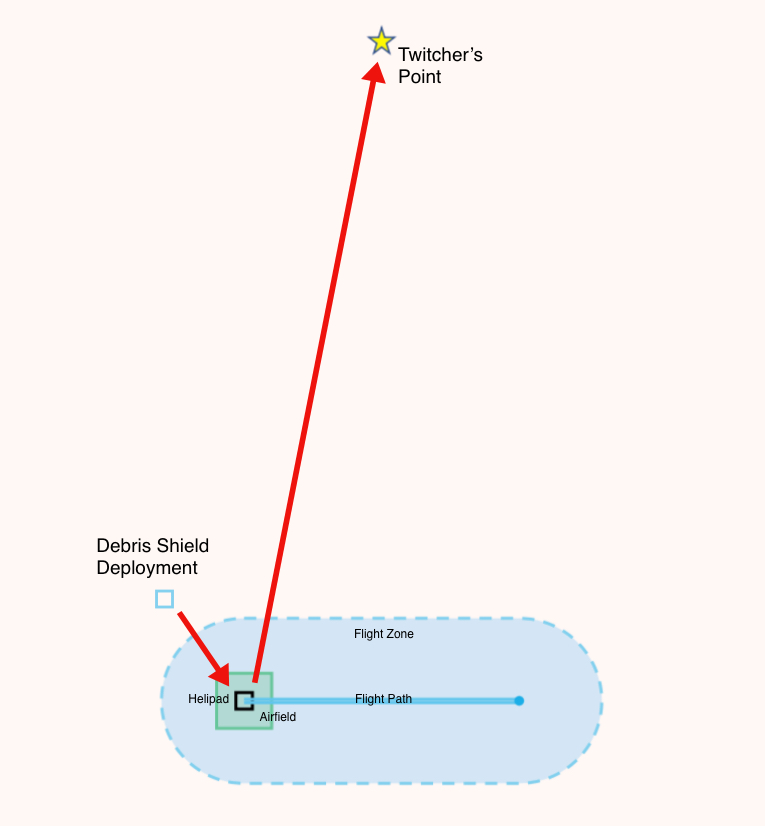 A schematic of the flight zone (blue oval) where Ingenuity will conduct its first flight activities. First, Perseverance will drop the debris shield covering Ingenuity, drive to the helipad (innermost box) to drop off the helicopter, and then move out to a safe distance at Twitcher’s Point (the star). The helicopter would start its test program at the helipad, fly out a pre-programmed flight path, and return again to the helipad. Image credit: NASA/JPL-Caltech | View larger image
A schematic of the flight zone (blue oval) where Ingenuity will conduct its first flight activities. First, Perseverance will drop the debris shield covering Ingenuity, drive to the helipad (innermost box) to drop off the helicopter, and then move out to a safe distance at Twitcher’s Point (the star). The helicopter would start its test program at the helipad, fly out a pre-programmed flight path, and return again to the helipad. Image credit: NASA/JPL-Caltech | View larger image
Engineers looking for a desirable airfield will evaluate the following criteria:
- Helipad (innermost box in graphic above): A 10-by-10-foot (3-by-3-meter) area where Perseverance will deploy the Ingenuity Mars Helicopter. Preferably, the box should be free of rocks more than 2 inches (5 centimeters) high and should be sloped no more than an average of around 5 degrees.
- Airfield (larger box): A 33-by-33-foot (10-by-10-meter) area surrounding the helipad. The surface should have as few rocks as possible exceeding 2 inches (5 centimeters) in height and have an average slope of no more than approximately 4 degrees.
- Flight zone (flattened oval): The area is defined by a boundary that extends horizontally 50 feet (15 meters) – in any direction – beyond the Mars Helicopter’s expected flight path during test flights. The terrain inside the zone must have sufficient visual features for the helicopter to track its movements using the onboard navigation camera.
- Debris shield deployment box (blue box above the oval): The location where the debris shield will be dropped (exposing the Mars Helicopter to the Martian environment for the first time). The box will be located 50 feet (15 meters) or more from the edge of the helipad. The optimal 10-by-10-foot (3-by-3-meter) box would have no more than a 10-degree slope and no obstructions (rock or surface bumps) that reduce rover ground clearance by over 2 inches (5 centimeters).
- Twitcher’s point (star): Perseverance’s parking spot during the Ingenuity flight tests. “Twitcher” is a British (and now Martian) term for those who travel long distances to see a rare bird. Located about 330 feet (100 meters) from the edge of the flight zone, the site should be relatively level. Twitcher’s Point also must allow direct line-of-site between the rover and the helicopter during all portions of potential flight tests for optimal radio communications and imaging.
Helicopter Deployment Phase
This sequence of activities, which is expected to take 10 sols if all goes well, begins with the deployment of the debris shield and ends with the helicopter on the surface of Mars. Each step is accompanied by communications back to Earth (via the rover and orbiters and NASA’s Deep Space Network) along with periodic transmission of pictures taken by the rover’s cameras, including the WATSON imager that is part of the SHERLOC instrument located on the end of the rover’s robotic arm.
This period will include the rover’s drive to the center of the helipad, the release of the lock on the Mars Helicopter Delivery System and slow rotation of the helicopter down to the surface, deployment of the helicopter’s legs, the charging of the batteries to 100%, and then the gentle drop 6 inches (15 centimeters) to the surface on the last sol. After the drop, Perseverance drives away to expose Ingenuity to the Sun so the helicopter can recharge its batteries.
Milestones
Once Ingenuity is deployed to the surface, it has 30 sols (31 Earth Days) to complete its activities. The first phase is a commissioning process that is expected to take about a week; then the first flight tests begin.
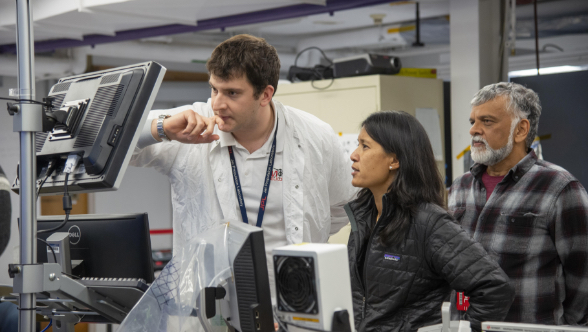 Image credit: NASA/JPL-Caltech | Full image and caption
Image credit: NASA/JPL-Caltech | Full image and caption
At the beginning of Ingenuity’s surface operations, the helicopter will aim to hit the following milestones:
- Autonomously keeping warm through the intensely cold Martian nights (as frigid as minus 130 degrees Fahrenheit, or minus 90 degrees Celsius).
- Autonomously charging with its solar panel.
- Confirming the communications link: between the helicopter and its base station; between the base station and the rover’s communication system; and then between the rover and Earth, all the way back to the helicopter flight operators.
- Unlocking its rotor blades, confirming blades can change their angle, or pitch, and then performing both low-speed (50 rpm) and high-speed (2,400 rpm) spin tests while still standing on the surface.
Once Ingenuity is certified for its test flights, it will attempt:
- Lifting off for the first time in the thin Martian atmosphere
- Flying autonomously
- Landing successfully
If all those steps are successful, Ingenuity will attempt up to four additional test flights.
First Experimental Flight Test on Another World
Mars Flight Test No. 1 is scheduled to launch at about 11 a.m. local time on Mars, when winds in the area are expected to be lightest and the battery will be at an adequate state of charge. In addition to using existing wind models, the teams will also be regularly checking data from the rover’s Mars Environmental Dynamics Analyzer (MEDA) instrument, which will provide data on the winds in the vicinity.
By the time of liftoff, the helicopter’s flight computer will have autonomously run through a series of preflight checks and run the rotor system to around 2,400 rpm. If everything remains go, the computer will command the rotor blades to change their angle, or pitch, taking a deeper bite into the tenuous Martian atmosphere. The first attempt at powered, controlled flight from Mars will begin a fraction of a second later.
The goals of Flight Test No. 1: lift off, climb, hover, and land. Ingenuity will be tasked with climbing at about 3 feet per second (1 meter per second) to an altitude of about 10 feet (3 meters). Then it is expected to hover for about 20 seconds and descend at about 3 feet per second (1 meter per second) until touchdown.
Flight tests will be divided into three-sol blocks. In addition to flying the helicopter, engineers use the first sol of each block for activities, including finalizing and transmitting the command sequences and acquiring preliminary data after the flight test’s completion. As soon as these first glimpses (including two low-resolution images taken in-flight) are downlinked, the Ingenuity team will begin reconstructing the vehicle’s performance and planning the next sortie. The second day’s communication from the helicopter will include all the engineering data acquired during the test. The images taken during the flight (up to four black-and-white navigation and three color) will be received on Day 3, providing the helicopter team an even clearer “picture” of what took place in the air millions of miles away. Later that evening, the team will meet to decide whether to begin a new test block the following day and, if so, what kind of flight profile to attempt.
Flight Test No. 2 and Beyond
If the team declares the first test flight a success, the goals of Flight Test No. 2 could be expanded to include climbing to 16 feet (5 meters) and then flying horizontally for a few feet (meters), flying horizontally back to descend, and landing within the airfield. Total flight time could be up to 90 seconds. Images from the helicopter’s navigation camera will later be used by project team members on Earth to evaluate the helicopter’s navigation performance.
If the second experimental test flight is a success, the goals of Flight Test No. 3 could be expanded to test the helicopter’s ability to fly farther and faster – up to 160 feet (50 meters) from the airfield and then return. Total flight time could be up to 90 seconds.
If the project timeline allows for Flight Tests No. 4 and 5, the goals and flight plans will be based on data returned from the first three tests. The flights could further explore Ingenuity’s aerial capabilities, including flying at a time of day where higher winds are expected and traveling farther downrange with more changes in altitude, heading, and airspeed.
Perseverance’s Role
Based 330 feet (100 meters) from the center of Ingenuity’s airfield, Perseverance will have an unencumbered view of the helicopter, whether on the surface or in flight. The rover will act as a communications relay between Ingenuity, Mars orbiters, and mission controllers on Earth. Perseverance’s MEDA instrument is expected to provide meteorological information (including data on airborne dust), while its Mastcam-Z and navigation cameras will collect still images of Ingenuity – and possibly a video or two. The rover’s two microphones (one located on the SuperCam instrument; the other, on its chassis) will attempt to pick up the sounds of the flight operations.
At the conclusion of the Ingenuity Mars Helicopter flight test program, Perseverance will begin to carry out its ambitious science mission: searching for signs of ancient microbial life, characterizing the climate and geology of Mars, and collecting carefully selected samples for future return to Earth. Find more on Perseverance’s science objectives in the Science section of the Perseverance rover press kit.



